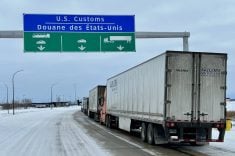On June 1, three months to the day after he told Canadian Federation of Agriculture delegates that their farm aid glass was 55 percent full, agriculture minister Lyle Vanclief announced the $500 million is on its way.
In most provinces farmers will receive their share of the federal-provincial payment before the end of June. In many cases, it is weeks later than promised.
However, not all farmers are equal under the program, since the federal government gave the provinces the lead role in designing the delivery.
It means the conditions, timeliness and amount of money vary by province. Some moved more quickly than others. Some provinces injected more than their required 40 percent share.
Read Also

VIDEO: Bittersweet harvest for this family farmhand
Bruce Burnett helps his brother harvest wheat and canola for the last time on the family farm in Manitoba where they both grew up.
Ontario and Alberta farmers fared the best, getting their money quickly and simply. They did not wait for Ottawa’s share to start sending out money.
Ontario’s program was the fastest, getting cheques out in April based on historic yield and price calculations for eligible crops. Alberta’s was the richest as the province agreed to spend 60 cents for every 40 federal cents and starting the cheques flowing in late May.
During a May 31 appearance before the House of Commons agriculture committee, Ontario Corn Producers’ Association president Dennis Jack noted that some provinces are paying more than their minimum share.
“The fact that some provinces have chosen to provide support at levels above the usual 60:40 federal-provincial ratio reflects a failure by Ottawa to provide leadership on this issue,” he told MPs.
Earlier, Ontario Federation of Agriculture president Jack Wilkinson said when Ontario moved quickly to spend its own money in early spring, “questions about the federal money’s whereabouts intensified.”
Other provinces, including Saskatchewan, complained that their payments required federal dollars but Ottawa delayed the process with some bureaucratic bungling.
“I’m really quite upset by it because I made a commitment following the April announcement that cheques would be out by the end of May,” Wilkinson said. Now, it will be mid-to-late June.
In light of Vanclief’s June 1 announcement that money was heading out of the capital, provincial governments were revving up their delivery programs:
- Ontario receives $104 million from Ottawa. It has added $70 million, plus $20 million in unspent provincial contributions from last year. The edible fruits and vegetables sector will receive more than $36 million of the federal help, with payments based on net eligible sales.
Grains and oilseeds farmers will receive the rest, plus the bulk of provincial money. It is distributed based on 85 percent of historic prices, multiplied by traditional yields.
Payments range from 20 cents per bushel of corn to 23.4 cents for winter wheat, 26.55 cents for red spring wheat and 47.7 cents for soybeans.
- Manitoba receives $55.2 million from Ottawa, to be supplemented by $37 million from the province. It will be distributed through Net Income Stabilization Account rules.
- Saskatchewan will receive $120 million from Ottawa, to be supplemented by $80 million from Regina. Payments will be based on a portion of net eligible sales, using NISA numbers to calculate producer payments.
- Alberta receives $126.8 million in federal funding, supplemented by $191.2 million from the province. Cheques started to flow from Edmonton in late May, using a payment of $10.29 per cultivated acre based on year 2000 acreage.
- British Columbia will receive $24.4 million from Ottawa, to be supplemented by $16 million provincially. The newly elected Liberal government hasn’t yet announced how it will design the provincial program.
















